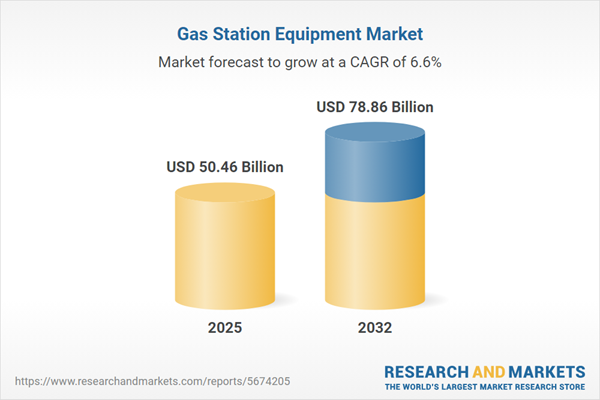Speak directly to the analyst to clarify any post sales queries you may have.
The gas station equipment market is experiencing rapid advancement, as industry leaders adopt digital solutions and prioritize sustainability across sites and operations. Senior decision-makers must stay ahead of shifting regulatory and technological landscapes to ensure robust, future-ready strategies.
Market Snapshot: Gas Station Equipment Market Growth and Outlook
The gas station equipment market is growing steadily, driven by widespread upgrades and modernization across retail fueling environments. Recent digitalization trends have prompted operators to enhance payment and site management systems to comply with regulatory requirements and meet rising customer expectations. As regulatory demands change and consumers seek seamless experiences, leading suppliers are investing in platforms that deliver both operational efficiency and adaptive functionality for different regulatory landscapes. These shifts are reshaping competitive dynamics and influencing the long-term strategies of industry participants.
Scope & Segmentation of the Gas Station Equipment Market
This market report examines the core segments, innovative technologies, and strategic considerations shaping the current gas station equipment industry. Each segment contributes directly to improved business outcomes and operational continuity.
- Fuel Dispensers: Integration of electronic and mechanical dispensers enables petrol stations to meet evolving multi-fuel requirements while supporting sustainability initiatives in line with global standards.
- Car Wash Systems: In-bay, self-serve, and tunnel models boost on-site efficiency and expand service portfolios, driving additional revenue and enhancing customer retention.
- Payment Systems: Deployment of secure, cloud-based POS and mobile platforms facilitates seamless digital transactions and enhances compliance both at the pump and in-store.
- Convenience Store Equipment: Advanced merchandising solutions, including next-generation beverage dispensers and refrigeration units, encourage higher basket value and increase the frequency of customer visits.
- Air and Water Equipment: Offering air dispensers, water units, and vacuums broadens available services and strengthens the station’s comprehensive service proposition.
- Lube Equipment: Modern lubricating systems sustain operational relevance in regions where internal combustion vehicles dominate, contributing to customer satisfaction and site profitability.
- Regional Coverage: Strategic approaches differ globally, as the Americas, Europe, Middle East and Africa, and Asia-Pacific each reflect unique regulatory environments and readiness for technological change.
- Company Coverage: Industry leaders such as Gilbarco Inc., Dover Fueling Solutions Inc., OPW Fueling Components LLC, Axess Industries S.A.S., Tatsuno Corporation, Franklin Fueling Systems LLC, Piusi S.p.A., Hectronic GmbH, Bennett Pump Company, Inc., and Varec Inc. are emphasizing supply chain resilience and robust risk management.
Key Takeaways for Senior Decision-Makers
- Adoption of IoT-enabled platforms elevates predictive maintenance capabilities, allowing real-time monitoring to minimize downtime and boost equipment dependability.
- Cloud-based, contactless payment solutions align operational processes with emerging regulatory frameworks and support an improved, unified customer experience throughout the fuel station environment.
- Deploying modular hardware supports agile upgrades, enabling operators to quickly adjust to new compliance standards and integrate novel technologies as market conditions evolve.
- Regional market maturity guides investment focus, with established regions seeking continual process improvements, while rapidly developing markets prioritize scalable infrastructure and technology solutions to support long-term growth.
- Maintenance contracts directly linked to service usage offer granular budget control by tying expenditure to actual equipment utilization, supporting smarter cost management.
- Strategic partnerships and tailored solutions help organizations adapt to fast-moving regulatory updates and shifting industry risks, ensuring operational agility.
Tariff Impact: Managing Cost and Sourcing Challenges
Recent developments in U.S. tariff policies have added complexities to sourcing and cost management for manufacturers and suppliers in the gas station equipment sector. In response, companies are expanding supplier networks, implementing near-shoring approaches, and investing in advanced supply chain controls. This strategic focus improves resilience to external shocks, reduces compliance exposure, and supports ongoing consolidation across the market.
Methodology & Data Sources
This analysis is built on input from official industry filings, technical white papers, published patents, and peer-reviewed market research. Direct feedback from senior managers and operations specialists further grounds the findings in real-world business priorities and execution realities.
Why This Gas Station Equipment Market Report Matters for Senior Leaders
- Clarifies the impact of changing sector regulations and technology trends on investment, procurement, and strategic planning, empowering executives to drive effective transformation.
- Details how differing adoption rates and compliance demands across regions can unlock risk mitigation opportunities and support operational flexibility in global portfolios.
- Supports competitive agility with actionable insights tailored to ongoing developments in the gas station equipment market.
Conclusion
This report provides senior decision-makers with the actionable intelligence needed to anticipate industry trends, secure operational advantages, and align strategies to the evolving dynamics of the gas station equipment market.
Additional Product Information:
- Purchase of this report includes 1 year online access with quarterly updates.
- This report can be updated on request. Please contact our Customer Experience team using the Ask a Question widget on our website.
Table of Contents
3. Executive Summary
4. Market Overview
7. Cumulative Impact of Artificial Intelligence 2025
Companies Mentioned
The companies profiled in this Gas Station Equipment market report include:- Gilbarco Inc.
- Dover Fueling Solutions Inc.
- OPW Fueling Components LLC
- Axess Industries S.A.S.
- Tatsuno Corporation
- Franklin Fueling Systems LLC
- Piusi S.p.A.
- Hectronic GmbH
- Bennett Pump Company, Inc.
- Varec Inc.
Table Information
| Report Attribute | Details |
|---|---|
| No. of Pages | 189 |
| Published | October 2025 |
| Forecast Period | 2025 - 2032 |
| Estimated Market Value ( USD | $ 50.46 Billion |
| Forecasted Market Value ( USD | $ 78.86 Billion |
| Compound Annual Growth Rate | 6.5% |
| Regions Covered | Global |
| No. of Companies Mentioned | 11 |









